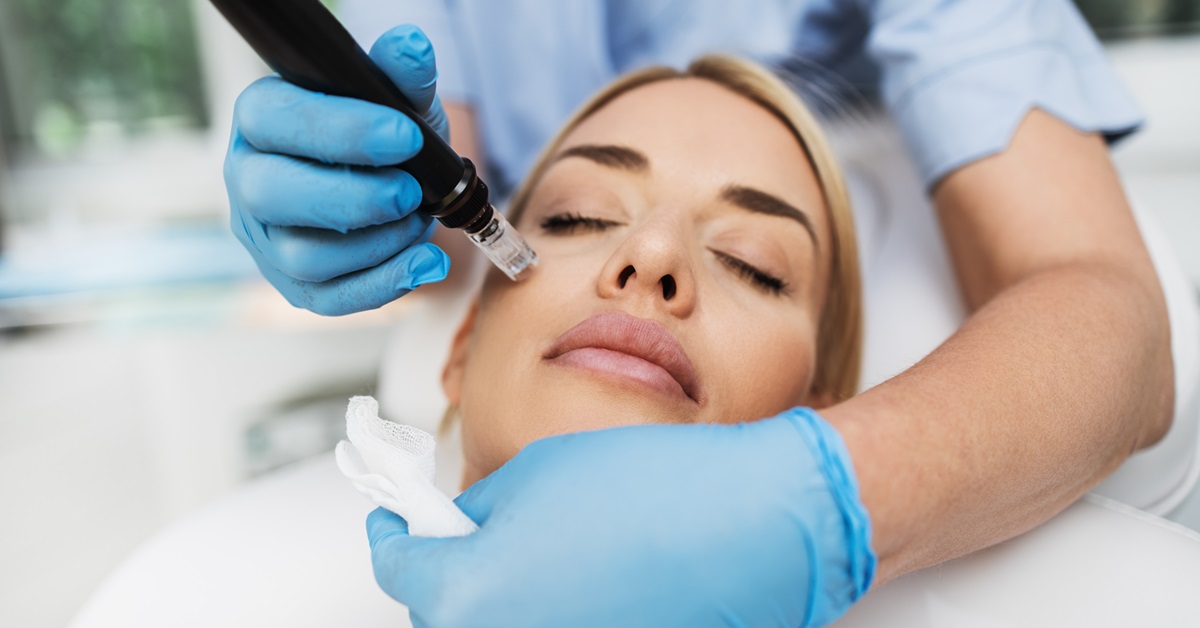What is Microneedling and Why is it So Popular?

Microneedling is a popular cosmetic procedure that involves using tiny needles to create controlled micro-injuries to the skin. These micro-injuries stimulate the body’s natural healing response, resulting in the production of collagen and elastin, which are essential for maintaining healthy, youthful-looking skin. The procedure can be performed on the face, neck, and other parts of the body to improve the appearance of acne scars, wrinkles, stretch marks, and uneven texture.
How Does Microneedling Work?
During a microneedling session, a device with fine needles is gently rolled or stamped onto the skin. The tiny punctures created by the needles trigger collagen production and promote the absorption of skincare products, such as serums or creams. The controlled injury stimulates the skin to regenerate and repair itself, leading to smoother, firmer, and more even-toned skin over time.
Microneedling has gained popularity due to its effectiveness and versatility. It is suitable for all skin types and can address various skincare concerns. The procedure is minimally invasive, with minimal downtime and discomfort. Many people opt for microneedling as a non-surgical alternative to treatments like laser resurfacing or chemical peels.
Overall, microneedling is a widely used procedure for achieving rejuvenated and healthier-looking skin. The treatment offers numerous benefits and can be personalized to meet individual needs and goals, making it a popular choice in the world of cosmetic dermatology.
Benefits of Microneedling
Microneedling has become increasingly popular in the world of skincare due to its numerous benefits. Let’s explore two key advantages of this innovative treatment.
Improved Skin Texture and Tone
One of the primary benefits of microneedling is its ability to improve the overall texture and tone of the skin. The treatment stimulates collagen production, which helps to smooth out rough patches, reduce the appearance of acne scars, and even out skin discoloration. This can result in a more youthful and radiant complexion.
Reduction in Fine Lines and Wrinkles
Another coveted benefit of microneedling is its ability to reduce the appearance of fine lines and wrinkles. By causing controlled micro-injuries to the skin, this treatment prompts the body to naturally produce more collagen and elastin. Over time, this can lead to tighter, plumper skin, and a decrease in the visibility of fine lines and wrinkles.
In summary, microneedling is a popular skincare treatment that offers a range of benefits, including improved skin texture and tone, as well as a reduction in fine lines and wrinkles. Whether you are looking to address specific skin concerns or simply enhance the overall health and appearance of your skin, microneedling may be worth considering.
Different Types of Microneedling
- Traditional microneedling is a minimally invasive cosmetic procedure that involves creating micro-injuries in the skin using a device called a derma roller or a derma pen. This stimulates the production of collagen and elastin, which helps improve the skin’s texture and appearance. It is commonly used to treat acne scars, wrinkles, and hyperpigmentation. The procedure is relatively painless and requires little to no downtime.
- Microneedling with radiofrequency (RF) combines traditional microneedling with the application of radiofrequency energy. The use of RF energy enhances the collagen-stimulating effects of microneedling, leading to even better results. This combination treatment is effective for tightening sagging skin, reducing fine lines and wrinkles, and improving skin tone and texture. It is safe for all skin types and typically requires a series of treatments for optimal results.
Both traditional microneedling and microneedling with RF have gained popularity due to their effectiveness and minimal downtime. These procedures offer a non-surgical alternative for individuals seeking skin rejuvenation and improvement in various skin concerns.
Microneedling Aftercare
After undergoing microneedling treatment, it is crucial to follow a proper aftercare routine to ensure optimal results. Here are some important tips to keep in mind for post-treatment care and long-term maintenance.
Post-Treatment Skincare Routine
- Cleanse and moisturize: Cleanse your face gently using a mild cleanser to remove any dirt or impurities. Follow it up with a hydrating moisturizer to keep your skin hydrated and promote healing.
- Avoid sun exposure: Protect your skin from direct sunlight by wearing a broad-spectrum sunscreen with a high SPF. Sun exposure can increase the risk of hyperpigmentation and skin damage after microneedling.
Long-Term Maintenance
- Follow-up treatments: Depending on your specific needs and goals, you may require multiple microneedling sessions. Consult with your dermatologist or skincare professional to determine the appropriate treatment schedule for optimal results.
- Use recommended skincare products: Incorporate skincare products recommended by your healthcare provider to enhance the results of microneedling. These may include serums containing hyaluronic acid or growth factors to promote collagen production and skin regeneration.
Remember to consult with one of our board-certified dermatologists or aestheticians before undergoing microneedling and for personalized aftercare guidance. Following these aftercare tips can help you achieve the best possible outcomes and maintain the health and appearance of your skin.
Microneedling vs. Other Skin Treatments
Microneedling has gained popularity in recent years as a highly effective skin treatment. But how does it compare to other commonly used treatments like chemical peels and laser resurfacing?
Comparison with Chemical Peels
Chemical peels involve the application of a chemical solution to the skin, which causes controlled skin damage and peeling. While chemical peels can effectively treat certain skin concerns, they may have a longer recovery period and carry a greater risk of side effects compared to microneedling. Microneedling, on the other hand, stimulates collagen production and promotes skin rejuvenation through tiny needle punctures, resulting in smoother, firmer skin with minimal downtime.
Comparison with Laser Resurfacing
Laser resurfacing uses laser energy to remove the outer layers of the skin, encouraging new skin growth and improving skin texture and tone. While laser resurfacing can produce remarkable results, it also requires a longer recovery period and carries a higher risk of complications such as pigmentation changes. Microneedling, with its minimal downtime and low risk of complications, offers a safer and more accessible option for achieving similar rejuvenating effects.
While chemical peels and laser resurfacing have their own benefits, microneedling stands out as a safe, effective, and increasingly popular treatment option for achieving improved skin texture, tone, and overall rejuvenation.
Is Microneedling Safe?
Microneedling has gained immense popularity in recent years for its ability to address various skin concerns effectively. This minimally invasive procedure involves the use of fine needles to create tiny punctures in the skin, stimulating collagen production and promoting skin rejuvenation.
Potential Risks and Side Effects
While microneedling is considered safe, it’s essential to be aware of potential risks and side effects. Some individuals may experience temporary redness, swelling, or mild discomfort after the treatment. In rare cases, there is a risk of infection or scarring if proper sterilization procedures are not followed. It is crucial to consult with a qualified professional and ensure that the procedure is performed in a clean and controlled environment.
Suitability for Different Skin Types
Microneedling is suitable for various skin types and can be customized to address specific concerns. Whether you have acne scars, fine lines, uneven texture, or hyperpigmentation, microneedling can help improve the appearance of your skin. It is important to consult with a skincare professional to determine the suitability of microneedling for your specific skin type and concerns.
In conclusion, while microneedling has become popular for its effectiveness in improving skin appearance, it is important to understand the potential risks and consult with a professional before undergoing the treatment.
Microneedling for Specific Skin Concerns
Microneedling has gained significant popularity in recent years as a treatment option for various skin concerns. This minimally invasive procedure involves the use of tiny needles to create controlled micro-injuries to the skin, stimulating collagen production and improving skin texture and appearance.
Acne Scars and Hyperpigmentation
One of the main reasons why microneedling is so popular is its effectiveness in reducing the appearance of acne scars and hyperpigmentation. The micro-injuries created by the needles encourage the skin to heal and regenerate, resulting in smoother and more even-toned skin over time.
Stretch Marks and Cellulite
Another common concern that microneedling can address is stretch marks and cellulite. The needles create tiny punctures in the skin, promoting the production of collagen and elastin, which can help improve the appearance of these skin imperfections.
Some Final Thoughts
It’s important to note that microneedling should be done by a trained professional, as the depth of the needles and the technique used may vary depending on the specific skin concerns being targeted. Additionally, multiple sessions may be required for optimal results. Individuals with certain skin conditions or medical concerns should consult with a dermatologist or aesthetician before proceeding. Overall, the rising popularity of microneedling is a testament to its effectiveness in addressing various skin concerns and providing individuals with a rejuvenated and revitalized complexion.



